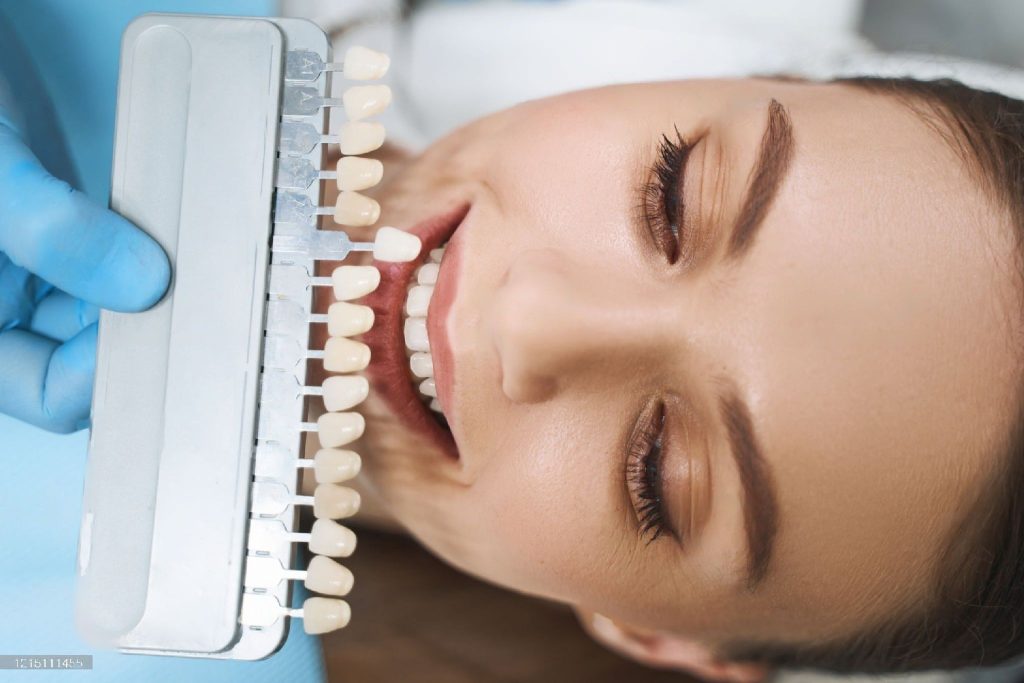FAQs About Cosmetic Dentistry

Cosmetic dentistry procedures like professional teeth whitening, bonding and porcelain veneers have grown by as much as 200% in the cosmetic dentistrypast decade, according to survey data from the American Academy of Cosmetic Dentistry (AACD). Whether you are interested in a whiter smile or fixing a few chips or gaps between your teeth, there are a number of procedures available to help you get a brighter and healthier smile at any age. The dentists at Ocotillo Trails Family Dentistry in Sun Tan Valley, AZ and serving Queen Creek, Dr. Matthew Roper, Dr. Nathan McLaws and Dr. Matthew Scheerhorn, offer a number of solutions for the most common cosmetic dental problems. Q: What is a Cosmetic Dentist? A: Cosmetic dentists can perform preventive and restorative dental care like dental exams, professional teeth cleanings, filling cavities, root canal therapy, and tooth extractions. Cosmetic dentists also offer aesthetic dental treatments like teeth whitening, porcelain veneers, cosmetic bonding and crowns. Q: When Should I Get a Cosmetic Dental Procedure? A: Cosmetic dentistry procedures address a range of dental problems, from stained and discolored to cracked, severely decayed, and even missing teeth. Some procedures are purely cosmetic, while others help to strengthen your teeth and improve your oral health while also making your smile look better. Discuss your options with your dentist to find the best option for you. You may like: Electric vs. Traditional Toothbrush Q: How Long Does a Cosmetic Dentistry Restoration Last? A: It depends on the type of procedure you choose. Porcelain veneers can last up to a decade and often longer, dental implants are designed to be a permanent replacement after tooth loss. The best way to preserve your oral health and any cosmetic improvements is to practice good oral hygiene habits, eat a healthy diet, avoid smoking, and see your dentist for preventive care at least once a year. Q: What are the Most Common Cosmetic Dental Procedures? A: The most common procedures include: Professional teeth whitening Porcelain veneers Cosmetic bonding Enamel (tooth colored) fillings Crowns and bridges Inlays/Onlays Dental implants Invisalign clear aligner trays Find a Cosmetic Dentist in Queen Creek, AZ You don’t have to wait for something to go wrong to make an appointment to see your dentist. The American Dental Association (ADA) recommends going to the dentist every six months to a year for a check up and professional dental cleaning to help prevent the onset of tooth decay and gum disease. For more information, contact Ocotillo Trails Family Dentistry in Sun Tan Valley, AZ by calling 480-457-1977 to schedule an appointment with a dentist today. You may like: Can Dental Procedures be Restored?
Cosmetic Dentistry Services and Treatments Offered at Our Practice

Who doesn’t want a beautiful smile that makes them feel and look their best? If you are dealing with stains, chips and other dental problems, you may find yourself hiding your smile or feeling as if your smile ages you. That’s where our San Tan Valley, AZ, cosmetic dentist Dr. Matthew Roper can help you. We specialize in a variety of cosmetic dental treatments that can fix the issues you’re dealing with while boosting your confidence. Here’s what you should know about the top three cosmetic dentistry treatments we offer, Teeth Whitening This is one of the most popular cosmetic treatments our dentist offers here in San Tan Valley, AZ. That’s because our professional whitening system offers immediate and significant results that you won’t find with over-the-counter whitening treatments and toothpaste. We can get your smile several shades whiter in just one hour, and professional whitening can be customized to your needs. Good candidates for teeth whitening: any healthy individual who maintains good oral hygiene who is dealing with yellowing or external dental stains caused by aging, diet or smoking. Dental Veneers Wondering how everyone in Hollywood seems to have such perfect teeth? Chances are good that many of them have dental veneers. These thin porcelain shells are adhered to the front of your teeth to whiten, reshape, and improve the overall appearance of your smile. If you are looking to make more major changes to your teeth without having to undergo serious dental procedures, then veneers may be right for you. Good candidates for dental veneers: any individual with strong, healthy teeth that can support veneers; anyone dealing with widespread cosmetic flaws such as crookedness, misshapen teeth, chips and stains. You may like: 3 Benefits of CEREC Technology Dental Bonding Have a single chipped tooth or a small gap between your front teeth? If so, then this simple cosmetic treatment may be all you need for a new, improved smile. Bonding is a non-invasive and conservative technique in which our cosmetic dentist will apply a tooth-colored resin to the area to help reshape it and improve its appearance. Good candidates for dental bonding: anyone who wants to make slight changes and improvements to one tooth or just a couple of teeth quickly and efficiently. If you are looking for a cosmetic dentist in San Tan Valley, AZ, that can help you get the beautiful smile you deserve, then call Ocotillo Trails Family Dentistry at (480) 457-1977 to schedule a cosmetic consultation. You may like: Patient Dental Education
Popular Types of Cosmetic Dentistry

You’ve finally decided it’s time to give your smile the makeover that it needs. But what cosmetic treatment aligns best with your Cosmetic Dentistry dental goals? Your San Tan Valley cosmetic dentist offers a full range of cosmetic dentistry services to accommodate your individual needs and budget. Take a look at some of our most popular options, and how they can improve your smile! Dental Bonding If you are looking for a non-invasive and conservative way to make small changes to your smile then dental bonding could be right for you. Dental bonding can hide severe stains, chips, cracks, minor gaps and overlapping. We first apply a tooth-colored resin to the problem areas and mold the putty-like material to the tooth. Once we have the proper shape we will use a laser to harden the resin to change the shape and look of your tooth permanently. Teeth Whitening For those looking to get a brighter smile from teeth whitening, in-office teeth whitening in San Tan Valley can get smiles up to 10 shades whiter in just one session. Our highly concentrated bleaching agent is applied to the teeth and a laser is directed at your smile to activate the gel. Each gel session takes about 15 minutes, after which we will remove the gel and reapply another layer. Three gel applications are performed during one visit, so you can get a noticeably whiter smile in just 45 minutes. Dental Veneers If you are looking to hide more moderate to severe stains, chips, overlapping, crookedness or spacing between teeth that dental bonding can’t fix, then dental veneers can help. These thin porcelain shells go over the front of your teeth using dental cement that we harden with a laser. This cosmetic treatment is minimally invasive and doesn’t require anesthesia; however, we will remove a trace amount of tooth enamel prior to applying the veneers, so the procedure is considered irreversible. Dental Implants If you are missing one, several or all of your teeth, dental implants can replace your smile. These screw-like metal posts are surgically placed into the jawbone where your missing tooth once was. Then a metal abutment is attached to the top of the implant. This abutment serves as a connector from which to hold an artificial tooth. A dental crown is then cemented to the abutment to complete your smile. While this process does take several months and can be costly, the benefits that patients receive with dental implants over other cosmetic treatments are well worth it. If you are interested in any of these cosmetic dental treatments then contact your San Tan Valley cosmetic dentist at Ocotillo Trails Family Dentistry, PLLC. Let us give you the smile you’ve been hoping for.



